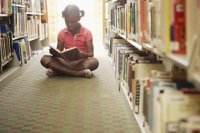Complex Texts: Guiding Readers One Step at a Time
Your content has been saved!
Go to My Saved Content.Like you, I've been doing a lot of thinking and wondering about text complexity. As a first grade teacher, I'm pondering what that concept means for young readers and guided reading instruction. How do we support readers as they gradually climb a staircase of texts that leads them to those with greater complexity? My research-guided experience says, "Let’s take it one step at a time!"
Step 1: Get to Know Your Readers
The more we know about our readers, the better we'll be able to scaffold instruction and lead them toward independence. To explain, let's zoom in on two assessments that help me when guiding readers:
- A reading interest survey
- A running record
I begin every year with a quick survey about my students' favorite topics. The data I collect helps me make instructional decisions that impact my book selections for read-aloud, for guided reading and for my students' individual book boxes. If I know that Sam is interested in trains, then I might entice him with a book like Freight Train by Donald Crews. After he's hooked, I'll hand him an informational book about trains that is a bit more complex but uses the same vocabulary as Freight Train, and so on.
When I do a running record with Sam on a book he's reading, I learn precisely which area(s) of reading to target during my guided reading lesson. Selecting a specific instructional focus -- like self-monitoring, decoding, fluency, vocabulary or comprehension -- strengthens the guided reading lesson. With a teaching focus and the students' interests in mind, I select a text. That leads me to the next step, because in order to select the most powerful books, you have to know the books.
Step 2: Get to Know Your Books
To guide readers toward reading increasingly complex texts, we have to put books in their hands that interest them and that will help them apply the essential strategies and skills. I have an idea for your professional learning community that will help you learn more about your books. Take a few hours to read and discuss the books you use for guided reading. Pass out some sticky notes, and invite your colleagues to jot down how they might use each book. Categorize the books by teaching focus:
- Self-Monitoring: Does the book have a clear illustration to text match?
- Decoding: Does the text contain known sight words along with those that might pose a decoding challenge like multi-syllabic words, words with endings, and so on?
- Fluency: Does the story include dialogue?
- Vocabulary: Does the book include vocabulary or concepts that are easily defined using context clues, visual cues or the glossary?
- Comprehension: Does the character change over time? Would it be a good book to discuss the lesson or the moral of the story?
Assign a recorder to compile your notes so that you can access them during the school year. Now that you know your books, you and your colleagues can work together to read and think about how to refine your instruction.
Step 3: Get to Know More About Powerful Teaching Frameworks
Professional books and collegial conversations are so helpful when ramping up your guided reading instruction. If you haven't read Jan Richardson's The Next Step in Guided Reading, I would recommend that you add it to your "someday" professional book list. Jan"s book helped me to understand how guided reading lessons change as children progress through the stages of reading development, from emergent readers to fluent readers. In addition, she clearly lays out a three-pronged approach to teaching guided reading that includes word study and guided writing. Whether you choose Jan's book or another resource on guided reading, engaging in ongoing professional conversations is the key to making changes in your instruction.
The Most Important Step: Enjoy Your Young Readers!
During our hectic days, we barely have time to go to the bathroom, let alone have lengthy, personalized conversations with our students. When we gather our young people for guided reading, it's another time during the day to look each student in the eye and say, "I'm glad you're here! Let's learn together!"
